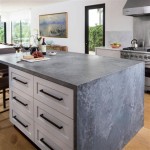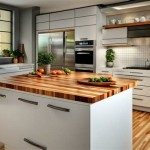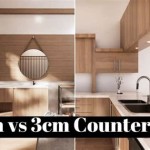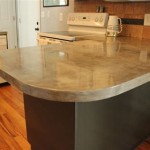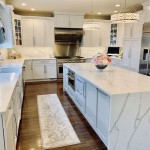What Is Standard Countertop Depth?
The standard countertop depth is a fundamental design element that significantly influences the functionality and aesthetics of a kitchen or bathroom. Understanding the standard measurements and variations allows for optimal space planning and a cohesive design. This article delves into the standard countertop depth, its implications, and factors to consider when selecting the ideal depth for specific needs.
Standard Countertop Depth
The standard countertop depth in the United States is 25 inches (63.5 cm). This measurement is widely adopted by kitchen and bathroom manufacturers, ensuring compatibility with cabinetry and appliances. A 25-inch-deep countertop provides ample space for food preparation, meal assembly, and storage of small appliances. It also allows for a comfortable reach to sink faucets and cooktops while maintaining a balanced workspace.
Variations in Countertop Depth
While 25 inches is the standard, there are variations in countertop depth to accommodate different preferences and space constraints. Some manufacturers offer countertops with depths ranging from 22 to 30 inches. A shallower depth of 22 inches may be suitable for smaller spaces or galley kitchens, where maximizing floor space is a priority. Conversely, a deeper depth of 30 inches offers increased workspace and storage potential, making it ideal for large kitchens or areas with ample space.
Factors to Consider
When selecting the ideal countertop depth, several factors should be considered:
- Kitchen or Bathroom Size: A smaller kitchen or bathroom may benefit from a shallower depth to avoid overcrowding. Larger spaces can accommodate deeper countertops for increased workspace.
- Appliance Placement: The placement of appliances, such as dishwashers and refrigerators, should be taken into account. A deeper countertop can provide more space for appliances to be recessed, creating a seamless and integrated look.
- Overhang: Countertop overhang refers to the amount of material that extends beyond the cabinetry. A standard overhang of 1 to 1.5 inches is recommended for bar seating or breakfast nooks. Deeper countertops can accommodate larger overhangs for additional seating or decorative purposes.
- Work Habits: Individuals who frequently prepare meals or use multiple appliances may prefer a deeper countertop for a more spacious workspace. Those who primarily use their kitchen for simple tasks may find a shallower depth sufficient.
Implications for Kitchen Design
The countertop depth plays a significant role in the overall kitchen design. A deeper countertop can create the illusion of a larger space by extending the perceived work surface. It also allows for a more ergonomic workspace, reducing strain on the back and neck during food preparation. Additionally, a deeper countertop can accommodate larger sinks and faucets, enhancing both functionality and aesthetics.
Conclusion
The standard countertop depth of 25 inches provides a balanced workspace in most kitchens and bathrooms. However, variations in depth are available to accommodate specific needs and preferences. By carefully considering the factors discussed above, homeowners and designers can select the ideal countertop depth to maximize functionality, enhance ergonomics, and create a cohesive and aesthetically pleasing design.

Standard Kitchen Counter Depth

A Homeowner S Guide To Kitchen Counter Height And Depth

What Is The Standard Depth Of Countertops Lx Hausys

Kitchen Cabinet Dimensions

Kitchen Standard Dimensions Essential Measurements

How To Measure Countertop Overhangs 101 Kitchen Design Concepts
Kitchen Counter Height Slab Platform Dimensions

Kitchen And Dining Area Measurements Standards Guide
Most Kitchen Layouts Start From The Concept Of A Work Triangle Between Sink Refrigerator And Cooking Surface Jlc

Standard Kitchen Counter Height Civil Scoops
See Also

